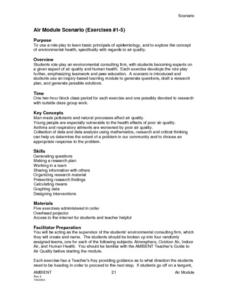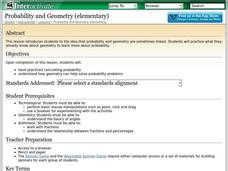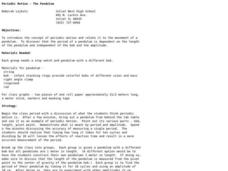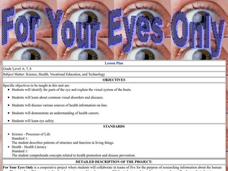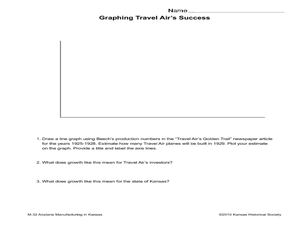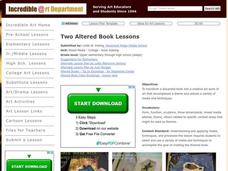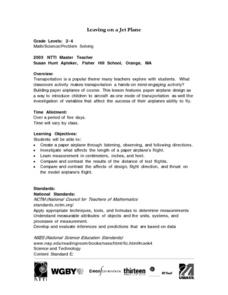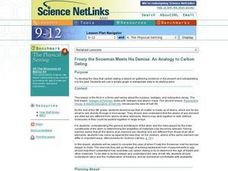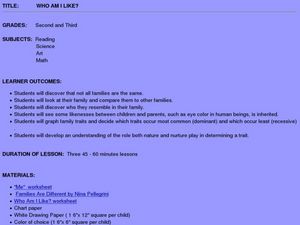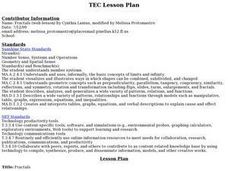Curated OER
What's the Matter? (Grade 3)
Third graders organize information about the three types of matter and to reinforce concepts learned in the matter unit of the science curriculum. They use Inspiration software to create a concept map of the three types of matter.
Curated OER
Designing Future Houses
Students discuss the changes we face and what kind of future house designs students can imagine. They create a floor plan, make an architectural drawing, and write a short description about their future house.
Curated OER
Air Module Scenario (Exercises #1-5)
Students, after researching/analyzing the concept of environmental health to air quality, role-play the basic principals of epidemiology. They act out a specific scenario to generate questions, draft a research plan, and generate...
Curated OER
Probability and Geometry
Young scholars examine the relationship between probability and geometry to solve problems. In this geometry and probability lesson plan, students investigate the effect of changing percentages on a spinner to the probability of landing...
Curated OER
Periodic Motion - The Pendulum
Students experiment to determine the period of a pendulum. In this periodic motion lesson, students use different pendulums to determine their periods. They use various amplitudes to determine its effects on the period.
Curated OER
For Your Eyes Only
Students complete several activities in a unit related to the eye. In this eye lesson, students work in groups to research information about the human eye and create a multimedia presentation. They research anatomy of the eye, how the...
Curated OER
Airplane Manufacturing in Kansas
Seventh graders determine how Kansas become a producer of airplanes. In this Kansas history instructional activity, 7th graders read selected Read Kansas! cards and articles. Students then discuss the primary sources they read regarding...
Curated OER
Effects of Bread Sanitary Conditions on Mold Growth
Students examine fungi and where it comes from. In this mold lesson students determine the percentage of fruit juice in a fruit then identify the different types of mold.
Curated OER
Laurence Yep's, Dragonwings
Students discuss vocabulary words and compare definitions. They read chapters 6-9 of the novel, Dragonwings, and discuss point of view, and complete a plot diagram. Then they review the four types of conflict and identify the conflicts...
Curated OER
BRIDGING THE GENERATION GAP
Students create a hypothesis about the attitudinal differences between generations, test their hypothesis with a survey, chart their findings, and present their answers to the class.
Curated OER
Immigration To Wisconsin
Fourth graders see why people came to Wisconsin and what life was like in their new home. They engage in a wonderful series of lessons, which use a variety of multi-media resources. They plan a heritage day party as a culminating event.
Curated OER
Internet Shopping Business Idea
Students create their own Internet business based on data they find concerning trends in Internet shopping. They discuss advantages and disadvantages to selling specific products and/or services over the Internet.
Curated OER
Altered Books
Learners transform a discarded book into a creative art work of art that encompasses a theme and utilizes a variety of media and techniques.
Curated OER
Leaving on A Jet Plane
Young scholars create an airplane by listening to directions. They also to measure the pieces for the airplane and compare and contrast their test flights.
Curated OER
El Nino
Students explain what El Nino is, where it is located and how it is created. They describe the weather changes caused by El Nino. They draw the patterns of El Nino on a world map. They predict economic effects El Nino has on the areas it...
Curated OER
Frosty the Snowman Meets His Demise: An Analogy to Carbon Dating
Students read and discuss an article about carbon dating, then participate in a hands-on lab to discover how carbon dating works. Students also write a letter to a friend explaining the process, and how archeologists use the process to...
Curated OER
Who Am I Like?
Young scholars examine family structures. In this family structure activity, students discover things about their own families and those of their classmates. They make a chart as they discuss nature versus nurture, complete a worksheet...
Curated OER
Bacteria and Illness
Students research information on bacterium and their relationship to food borne diseases. In this science lesson plan, students complete internet research to construct and analyze the growth cure of common bacterium and food-borne...
Curated OER
General Greene to General Marion: Your State is Invaded, Your All is at Stake
Third graders examine the contributions of Francis Marion and Nathaneal Greene. In this Revolutionary War lesson, 3rd graders use primary and secondary sources to research Marion and Greene and the accomplishments of their men during the...
Curated OER
Responsible Eating
Students identify healthy eating habits. For this nutrition lesson, students discuss the food pyramid and healthy food choices. Students track their daily food intake in a journal.
Curated OER
Equivalent Fractions
Students complete a worksheet. In this fractions lesson, students review their knowledge of fractions, define equivalent fractions, see examples of equivalent fractions and practice making equivalent fractions.
Curated OER
What are Fractals?
Middle and high schoolers identify and analyze fractals and research information using the Internet to locate information about them. They look at fractals in relation to nature and other real world situations. Pupils create several...
Curated OER
Age Structure Studies
Students collect data from Internet sources to compare age distributions in their city, county or state with that of other places in the US or other countries. They construct and interpret age-structure population pyramids and research...
Curated OER
Hoosier Artists
Students examine the paintings of various Indiana artists. Using the internet, they relate the landscapes shown to the history of the state and how it affected Native Americans. Using the information they gathered, they write story...




